Download
Here's the bottom line.
The CDC has confirmed no cases from surface contact and does not suggest that disposable items are safer than reusables.
Using sanitized reusable foodware for orders instead of disposables can save a restaurant on average $3,000-$7,000 annually, while also preventing harm to the environment.
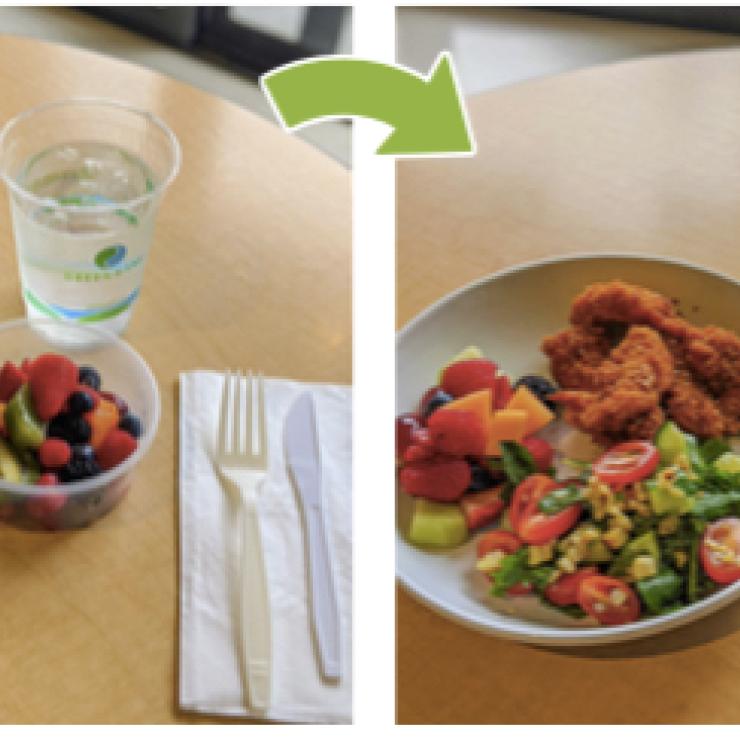
Restaurant Reopening
This guide specifically addresses what you need to know regarding the safety of reusable foodware. The CDC, FDA, OSHA, and state and local authorities have issued guidelines for safety during the COVID-19 pandemic for re-opening restaurants following the end of Shelther in Place orders. These guidelines detail best practices for the following:
- Social distancing (staff and customers)
- Systems to reduce contact and cross contamination
- Hand washing
- Disinfecting surfaces
- Face coverings
The CDC's guide for how to incorporate these into your business practices should be followed, however, their considerations are meant to supplement - not replace - any local, state, territorial, or tribal health and safety regulations. Practices should be implemented based on what is practical and acceptable to each community.

Safety of Reusables
According to the CDC, COVID-19 is mainly spread through respiratory droplets from talking, coughing, or sneezing when people are in close proximity. While surface contact is low risk, health experts still suggest that you should avoid touching your face after touching any potentially contaminated surface and that washing and sanitizing surfaces and hands reduces this risk further.
The CDC has confirmed no cases from surface contact and does not suggest that disposable items are safer than reusables. It is important to note that just because single-use foodware items have not been previously used, they still may have been exposed to COVID-19, may not be sanitary, and cannot be washed and sanitized. The supply chain following disposable products is often harder to track than the path of a reusable from the sanitizing machine/dishwasher to the consumer. Properly cleaning, sanitizing, and handling reusable foodware items allows you to best control potential exposure.
Standard Operating Regulations/Procedures
Restaurants are already required to follow strict health and safety regulations, including safety codes for washing and sanitizing food service items. The CDC's considerations for COVID-19 include additional resources for cleaning and sanitizing hands and surfaces - including reusable foodware items - with EPA-approved disinfectant products. The FDA's best practices also state that hot water can be used in place of chemicals to sanitize equipment and utensils in manual ware-washing machines and recommend verifying that your ware-washing machines are opperating at the required wash and rinse temperatures and with the appropriate detergents and sanitizers. The FDA does not suggest that single-use disposables are safer than reusables.
To-Go & Pick-Up Orders
Social distancing is still the best way to stop the spread of COVID-19. Therefore, drive-through, delivery, curb-side pick-up, and take-out are currently the best practices to prevent transmission of the novel coronavirus. This means that many restaurants will need to use a huge amount of take-out containers. Disposable foodware for take-out is not only harmful to the environment but also very costly to restaurant owners (see Appendix B). While a few pilot programs that supply, collect, and sanitize reusable take-out containers (see Appendix A) for restaurants have launched across the country, most take-out orders still rely on single-use disposable products.
For restaurants relying on to-go orders, you can save money and prevent waste by only providing accessory or additional single-use disposables by request, or by training your staff to ask before including accessory disposables with orders (i.e., plastic utensils, straws, napkins, condiment packages, etc.).
Use touchless payment options as much as possible. This is also an opportunity to ask before printing receipts to prevent contact and prevent unnecessary waste.
Some restaurants have implemented reusable systems for their take-out. Some systems expect the customer to either recycle the container or reuse in their own homes. Other systems include an additional deposit fee for the drink/meal in the reusable container. The guest receives the deposit back when the reusable container is returned. Althought the upfront cost of purchasing reusable containers may be more expensive than a single-use item, it's beneficial in that it:
- Elevates the dining experience
- Reduces waste generation
- Encourages guests to return as loyal regulars or because they need to return the reusable item to the restaurant
Dine-In Customers
Using sanitized reusable foodware for orders instead of disposables can save a restaurant on average $3,000-$7,000 annually, while also preventing harm to the environment. As the CDC's guidelines demonstrate, there are completely safe practices for using reusable foodware. With small businesses struggling to stay open because of the COVID-19 pandemic, business owners can use these waste prevention practices to help their bottom line.
- Replace disposable foodware with reusable foodware for on-site dining (i.e., plates, bowls, trays, cups, mugs, cutlery, etc.)
- Eliminate accessory disposable items or make them available upon request only (i.e., straws, stirrers, food wrap, etc.)
- Always ask if a meal is "for here" or "to go". If it's "for here", prioritize reusable foodware for the order
- Educate staff on the new reuse-centric policies and practices
- Display signage indicating changes made and customer options
Replacing individually wrapped items like condiments, sweeteners, and seasonings with bulk items is also a great way to save money and prevent waste, but this also exposes these items to a lot of contact. For now, COVID-19 precautions prevent this from being an option. To avoid bulk-serve stations, condiments can be given out upon request from a storage area of limited contact, or staff can add condiments to orders (such as pouring milk for customers) to avoid multiple people touching a container.
Shared items like menus may also be a concern. If possible, make sure they can be sanitized between uses. If this is not possible, instead of using disposable paper menus, you can encourage your customers to use digital menus or order ahead of time for contactless ordering.
Personal Bags and Cups
Charging for disposable cups or offering and advertising an incentive (such as a discount) for customers to bring their own (BYO) reusable cup, container, or bag is an effective way to save money and avoide single-use items. Based on a Clean Water Fund survey of 95 cafe owners in the eleven districts in San Francisco and 461 customers in the eleven districts of San Francisco, the most fair and appropriate charge that would motivate customers to BYO was between $0.10 and $0.25 per cup. These practices are still possible during the COVID-19 pandemic as long as businesses employ systems in which there is no contact between the reusable item and retail surface area or employees. The CDC has confirmed no cases from surface contact, but this is a precautionary measure to protect workers.
Sample COVID-19 Reuse Systems
Sanitation Station:
A sanitation station pictured below is used at a zero-waste cafe in Oakland, CA: MudLab. Customers are able to BYO MudLab glass jars that come with a lid and washable/reusable sleeve. The sanitation station is set up at the front entrance for customers to sanitize and rinse their BYO cup. Instead of folks bringing in their reusables for immediate use, they drop reusables in a collection station where MudLab employees or a third party dishwashing service (depending on the day) will then process/sanitize them for future use. Guests leave the cafe with a reusable jar that has already been sanitized.
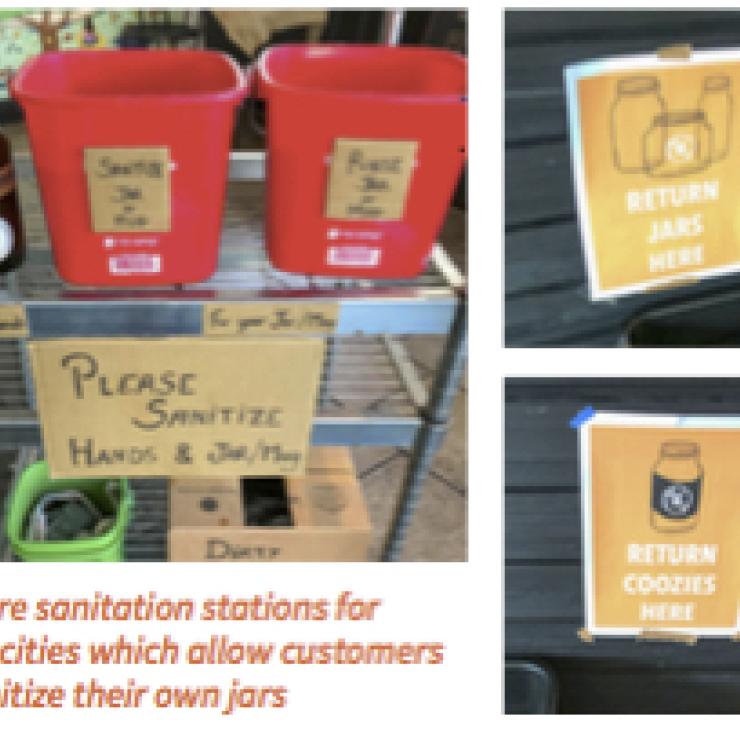
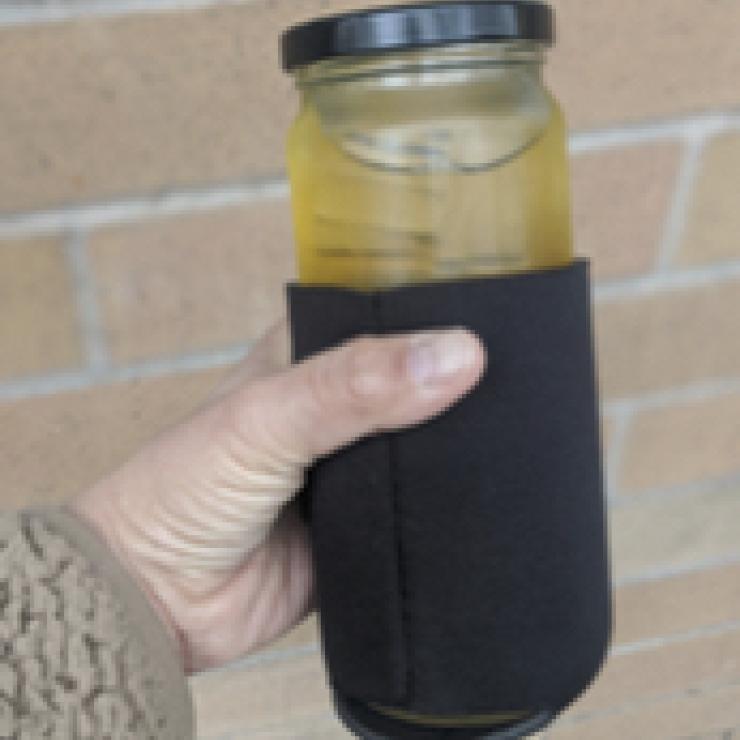
Third Party Dishwashing:
For some cities and states, third party dishwashing is necessary as the COVID-19 Pandemic continues. One way to coordinate this is to have a collection box/station outside of the establishment, and in this way, staff are protected from touching reusables until they have been professionally sanitized. Staff should always wear gloves and masks to touch reusables.
Some Third Party Dishwashing services include:
In-Store Sanitation Model:
This system requires more logistics, however it keeps long-term costs down and helps create loyal regular (and returning) customers. Staff are protected from touching reusables until they have been professionally sanitized.
Customer Training
Signage:
- Signage at several locations in the store are necessary to help customers understand the new system
- Signage can be translated into several languages
- Signage should include graphics depicting the system
- Signage should seek to gently remind customers of the negative effects of single-use plastics on the environment
- Signage can remind customers of downstream impacts of single-use plastics
Reminders:
- Reminders about returnable foodware systems (before ordering, during an order and before leaving) can help customers internalize the new system
- Reminders to bring back their jars should be friendly, patient, and kind
Incentive Systems:
- Discount for bringing a reusable (staff trained to remember EVERY time)
- Small charge for using a single-use disposable cup
- "Pay it Forward System" rewards people who bring reusables with free drinks or other incentives - folks just buy drinks for the next person in line
Collection and Reuse of Jars:
Cafes can benefit from the "return-a-jar systems" of companies such as Straus Milk. They not only redeem value when they return jars, but they also position themselves as low-waste to their customers and community. Additional benefits include reduced cost of trash removal from the business. Trash hauling is expensive and milk containers are bulky!
APPENDIX A: Helpful Links
FoodWare Calculator to determine the cost of your disposables
Cost Benefit Calculation of Disposable vs Reusable
Health Expert Statement Addressing Safety of Reusables and COVID-19
Grants For Transitioning To Reusables
Helpful Websites For Plastic Reduction
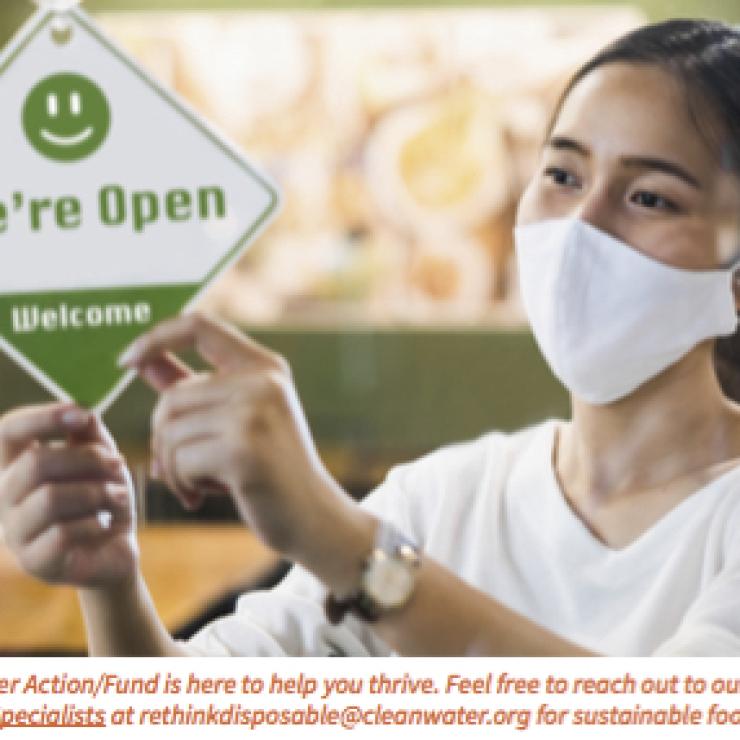
Sources:
Contra Costa County General Requirements for Restaurants during COVID-19
https://beyondplastics.org/article/ask-your-store-to-bring-back-reusables-refillables-during-covid/
https://www.cleanwateraction.org/
https://coronavirus.marinhhs.org/appendix-c-1-additional-businesses-permitted-operate
https://www.countyofnapa.org/DocumentCenter/View/17688/Stage-2-Business-Ops-FAQs-ENGLISH?bidId=
https://deh.acgov.org/deh-assets/docs/Covid19%20Guidance%20for%20Food%20Facilities%20-%20English.pdf
https://www.dir.ca.gov/dosh/Coronavirus/COVID-19-Infection-Prevention-in-Grocery-Stores.pdf
https://oceanic.global/wp-content/uploads/2020/07/Oceanic-Global-COVID-19-Reopening-Guidelines.pdf
https://www.sccgov.org/sites/covid19/Pages/learn-what-to-do.aspx#outdoor-dining
https://sf.gov/resource/covidoutdoordining
https://www.surfrider.org/coastal-blog/entry/how-to-reopen-restaurants-while-safely-using-reusables
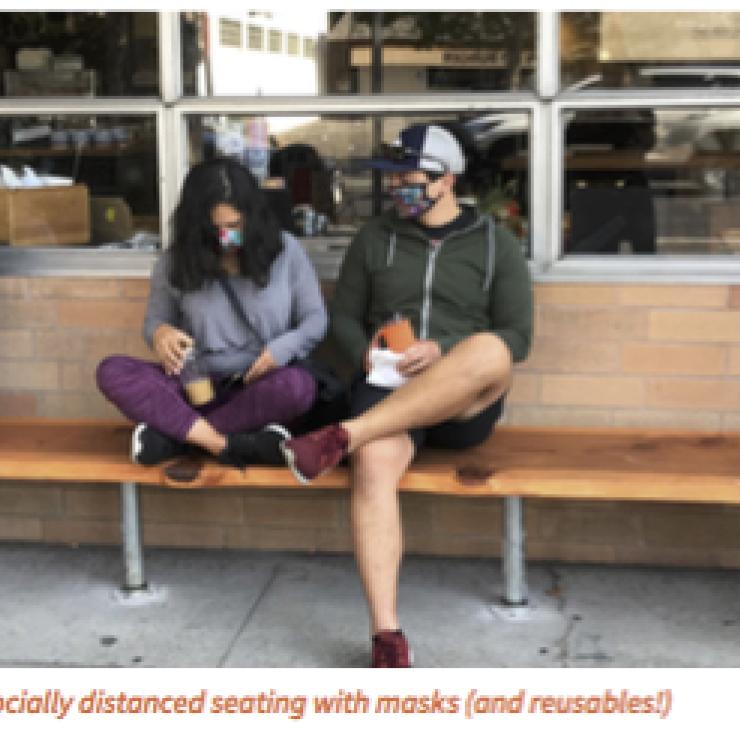
APPENDIX B: ReThink Disposable Resources
